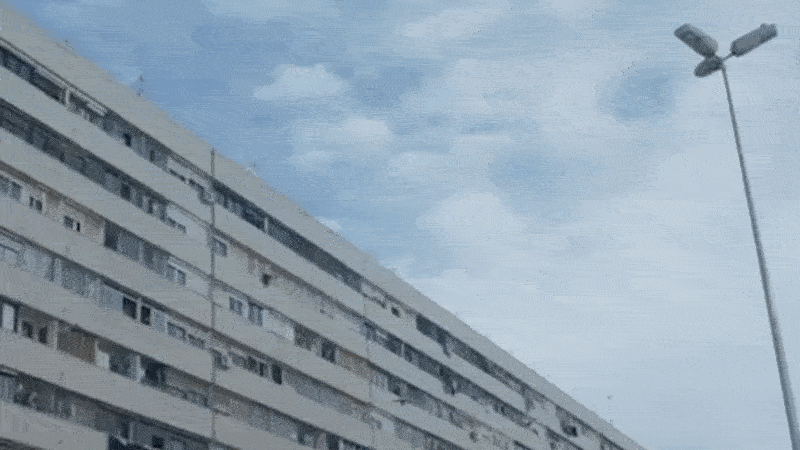Loading...
Itinerary
A dynamic low shot shows a scantily clad singer addressing the camera. Behind it, a very long linear block with the characteristic landscape of any neighbourhood on the outskirts of Madrid: closed balconies, green awnings and air-conditioning machines. Another shot, from the other side of the road, shows an almost identical repetition of these blocks. It is only the random situation of small additions to protect against lack of insulation or to gain a few square metres of living space that distinguishes one building from another. This architectural complex is known as "Las Colmenas", one of the first - and ultimately unsuccessful - collective housing developments after the Civil War, developed by the builder and property developer José Banús, a supporter of the dictatorial regime. Officially known as the Ampliación del Barrio de la Concepción (Extension of La Concepción Neighbourhood), it was given this nickname because of its extremely high density of housing. A housing model that had nothing to do with European standards of surface area and quality, but rather responded to a profit motive at the expense of building new neighbourhoods for a growing city with serious problems of informality.

Itinerary curated by
Bartlebooth
Bartlebooth is a publishing and research platform that examines contemporary spatial practice, founded in 2013 and currently developed by Antonio Giráldez and Pablo Ibáñez.
Means of transport
This is the starting point of our itinerary, a location that not only takes us to the years immediately after the Civil War, but also to an icon that, generation after generation, has been recovered in the Spanish audiovisual imaginary. From the wastelands of the 1970s quinqui cinema to the Oscar-winning Almodóvar's What have I done to deserve this? and countless recent urban music videos that use this same backdrop. Only one other building, twenty years later in its construction but quite similar in its approach, disputes this media hegemony with Las Colmenas in Madrid: the Venus building in Sant-Adriá del Besós, in the neighbourhood of La Mina. Sung by Los Chichos and portrayed in Street Dogs in the 1980s, it remains a nostalgic popular audiovisual icon to this day - despite the demolition and rehousing order for its inhabitants that has been pending for years - to the point that Netflix has donated money to its inhabitants in return for converting it into a film set.If hip hop and rap have reclaimed the collective housing block and the neighbourhood as minimum units of existence in the face of the homogenisation of the urban peripheries, contemporary audiovisual capacity allows these scenarios to be recorded in unthinkable detail. In many of today's productions, the block plays a key role. So let's take this fruitful relationship between urban music, architecture and video clips as a starting point for a journey through the evolution of recent Spanish collective housing.

In response to the great pressure for the regularisation of informal housing and shantytowns that had been dragging on since the first decades of the 20th century in the city of Madrid, different proposals were put forward by the public administration. Experiments in both public and private housing attempted to address this housing shortage through research into typologies that moved away from the idea of the block so prolific in European geography and modern precepts to venture, in some cases, into medium- and low-density developments. Vallecas, Pan Bendito, Fuencarral, Canillejas, Villaverde and Hortaleza were the sites for six neighbourhood shantytown absorption units that have now disappeared, with the exception of the last one, designed by Fernando Higueras. His construction was intended to be ephemeral, but to this day, it remains in increasingly precarious use.At the same time, while public initiative was shaping the then peripheral neighbourhoods, as in the case of Can Deu in Sabadell, private initiatives of radical modernity, formally detached from the constrictions of the first stage of the Franco regime, were also beginning to take shape. The same play with vegetation and cantilevered balconies used in the Hortaleza Neighbourhood Absorption Unit (UVA) was transferred to the centre of Madrid, replacing the low-quality materials with the figurative use of reinforced concrete so characteristic of Higueras's architecture. An exponent of an organic brutalism, as present in post-war European architecture as it is coveted as a recording spot in hip hop video clips by the few existing exponents in Spain. Dano -singer, producer and audiovisual producer- says that they had found in the few examples of Spanish brutalism a common element that allowed them to connect with a European imaginary far from the classic American brick buildings.



If the first cases - between emergence and radical density - sought to respond efficiently to the spatial realities derived from the country's internal migration processes, the examples of the 1960s and 1970s traversed by recent urban music added new layers of richness and complexity to the peripheries of many urban environments. From the organic aggregation of "cells" deployed in the Barri Gaudí in Reus - which fled from the dormitory-city model to incorporate other uses and programmes and thus dignify affordable housing - to the superposition of open and closed collective spaces in Can Mercader, in Badalona, or the late L'Espai Verd in Valencia, an opposing compactness which, nevertheless, interweaves the public and the private equally well. In parallel to public works, private initiative through developers, but above all through the strength of the neighbourhood movement of housing cooperatives, allowed experimentation with more daring architectural typologies capable of including services or new forms of relationship intermingled with the housing units. Unwittingly, the choreographed movements of Shainny, Morad, Bad Gyal, Dellafuente and Cazzu break the dichotomy between the inside and the outside, the public and the private, the individual and the collective, of these paradigmatic ensembles. As precise but much more subversive than any specialised magazine, these travellings are means and evidence of a constructed heritage resulting from a set of social realities materialised, with successes and failures, in spatial proposals.
Open and closed shots with impossible zooms now follow the artists as they walk along a wide pavement behind which a façade splashed with colour appears. In another video clip, extreme cantilevers loom over liberated ground floors and fenced-off spaces in between. Outside, we see modified cars crossing wide, empty avenues, with battery car parks between fenced-off wastelands waiting to be built on. The peripheries with which this itinerary began have been transformed half a century later into the stasis of urbanised plots without any real connection with the urban fabric. The scenario is now different. On YouTube, the rappers' tours of contemporary residential buildings do not show the spatial ambiguity of the Mediterranean examples of the 1970s, nor the programmatic complexity of the complexes erected on the outskirts of large cities, nor the courage or experimentation of some models designed against monofunctionality, segregation and under-focussing.

The Programas de Actuación Urbanística, popularly known as P.A.U.' (Urban Development Programs) and their counterparts erected everywhere at the turn of the century, kilometres away from the centres of medium-sized and large cities, now appear as unique models, without alternatives, to urban development (or growth). Designed for the sole purpose of housing, their homogeneous layouts, with similar geometry and scale established by increasingly rigid regulations, relegated the only spaces for the most radical architectural experimentation to the realm of the plot - and, therefore, the private sphere. And yet, they are and have been internationally celebrated examples of the consolidation of compositions and manners, reduced to the façade plane, a good part of their propositional richness. The colours, geometries and woodwork sections provide a vibrant, low-budget backdrop that the audiovisual productions use as the raw material for their video clips.

This affaire between the built environment and urban music is no coincidence. The scenarios are chosen for very specific spatial, visual or symbolic qualities that make the block transcend its functional plane and become part of an audiovisual circuit that is counted in millions of reproductions. The moving shots, far from the selective gaze of architectural photography, tell us about the stories and scars experienced by these buildings, allowing us to explore their spatial richness in a way that is collateral to the lyrics and bases of the songs reproduced. After all, if one of the principles of modern architecture was the dignification of collective housing, turning it into an architectural subject for experimentation and development, urban music made from the communities affected by this same architecture and urbanism that expelled them to the peripheries manages to put the block back in the centre. To refuse to understand these audiovisual pieces as a reliable record of Spain's contemporary architectural heritage is, to a certain extent, to refuse to listen to the other tales and stories built around each of these projects.







